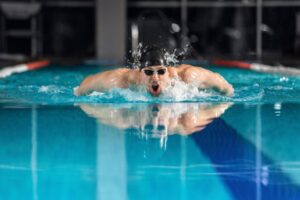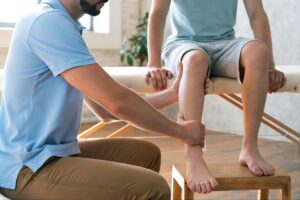The Anatomy of Sports Injuries: A Brief Overview
- Bones & Joints: Shoulder joint, elbow, wrist, lumbar spine (lower back), hips, knees.
- Muscles : Rotator cuff (stabilizes shoulders), core stabilizers (abs, obliques, spine muscles), scapular muscles (control shoulder blade).
- Tendons : Forearm extensors (elbow/wrist), patellar & hip tendons.
- Overuse injuries: These happen gradually from repeated motions and can cause tendon pain, swelling, or irritation.
- Acute injuries: These are sudden injuries like sprains or strains from a specific movement or accident.

Sport-Wise Breakdown
Tennis
- Key body parts: Elbow (outside), shoulder (rotator cuff), wrist, lower back.
- Common injuries: Tennis elbow, rotator cuff tears, wrist sprains.
- Why they happen: Repeating forehand and backhand movements strain tendons around the elbow and wrist. Stiffness in the back forces the arm to work harder.
- Prevention: Strengthen forearm muscles with eccentric exercises, use the right grip size on your racket, and improve shoulder and upper back stability.
Golf
- Key body parts: Lower spine, elbows, shoulders, knees.
- Common injuries: Lower back pain, golfer’s elbow, knee irritation.
- Why they happen: Rotational force plus poor posture during the swing stresses the back, elbows, and knees.
- Prevention: Build core strength, work on hip flexibility, and focus on good swing mechanics.
Swimming
- Key body parts: Shoulders (rotator cuff and shoulder blade muscles), knees (especially breaststroke), lower back.
- Common injuries: Swimmer’s shoulder, knee strain from breaststroke, back strain from excessive arching.
- Why they happen: Overhead motions irritate shoulders; repetitive kicking stresses knees; bad posture affects the lower back.
- Prevention: Strengthen shoulder stabilizers off the pool, stretch hip muscles, and refine swim technique for better efficiency.
| Sport | Key Stress Areas | Common Injuries | Why They Happen | Prevention Focus |
|---|---|---|---|---|
| Tennis | Elbow, shoulder, wrist, lower back | Tennis elbow, rotator cuff strains, wrist sprains | Repetitive strokes overload tendons, stiff spine compensation | Forearm strength, correct grip, shoulder stability |
| Golf | Lower back, elbows, knees, shoulders | Back pain, golfer’s elbow, knee strain | Rotation + poor posture stress joints | Core strength, hip mobility, swing technique |
| Swimming | Shoulders, knees, lower back | Swimmer’s shoulder, breaststroker’s knee, lumbar strain | Overhead strokes & repetitive kicks | Shoulder stabilizers, hip stretches, technique drills |

Recovery and Professional Guidance
- Rest from activities that cause pain.
- Ice the area to reduce swelling.
- Compression with bandages prevents excess swelling.
- Elevation keeps the injured part raised to lower inflammation.
Functional Manual Therapy (FMT): A Smarter Approach to Recovery
How FMT Works
Hands on Therapy : Therapists use precise hands-on techniques to release joint restrictions, muscle tightness, and fascial adhesions.
This restores normal mobility in the spine, shoulders, and hips — areas heavily stressed in tennis, golf, and swimming.
Neuromuscular Re-Education : Injuries often cause faulty movement patterns (e.g., overusing the wrist in tennis, rotating too much from the lower back in golf, or poor shoulder blade control in swimming).
FMT retrains your nervous system for more efficient, pain-free movements.
Functional Strength Training : Instead of isolated exercises, FMT emphasizes sport-specific movements.
Example: Core rotation drills for golf swings, scapular stability for swimming strokes, eccentric loading for tennis forearm tendons.
Benefits of FMT for Athletes
- Faster Recovery: Reduces pain and restores mobility quicker than passive treatments.
- Injury Prevention: Corrects biomechanical faults before they cause overuse injuries.
- Performance Boost: Optimizes joint alignment and muscle coordination, improving efficiency in strokes, swings, and kicks.
- Holistic Care: Doesn’t just treat the pain area but looks at the whole kinetic chain (shoulders–spine–hips connection).
Case study: three sports, one solution
Two months before a corporate tournament, Arjun, 36, cranked up tennis, weekend golf and pre-work pool sessions. By week three he felt elbow pain on backhands, a tight low back after the range and a front-of-shoulder ache during freestyle. Rest helped for a bit, then the cycle returned the moment he pushed pace.
At VARDĀN, assessment showed limited mid-back rotation, tight hips and underpowered shoulder-blade control. A focused block of Functional Manual Therapy (FMT) freed motion, rewired coordination and added capacity that matched his sports. Arjun went back to full sessions without flare-ups — and left with a plan to stay that way.
One-minute movement screen
- Wall reach: Both arms overhead. Any pinch or side-to-side difference?
- Seated trunk rotation: Turn right and left. Does one side block or feel stiff?
- Single-leg balance: Hold 20 seconds each side. Hip drop or wobble?
- Scapular set: Can you slide shoulder blades down and around ribs without shrugging?

Reset. Rebuild. Return.
Request an Appointment at VARDĀN, Lajpat Nagar, New Delhi for a personalised Functional Manual Therapy assessment and a sport specific rehab plan.
Call us today at +91 011 43580720-22 / 9810306730
📅 Book your root-cause consultation at www.vardan.in
📍 Visit our advanced physiotherapy clinic in Delhi in Lajpat Nagar




